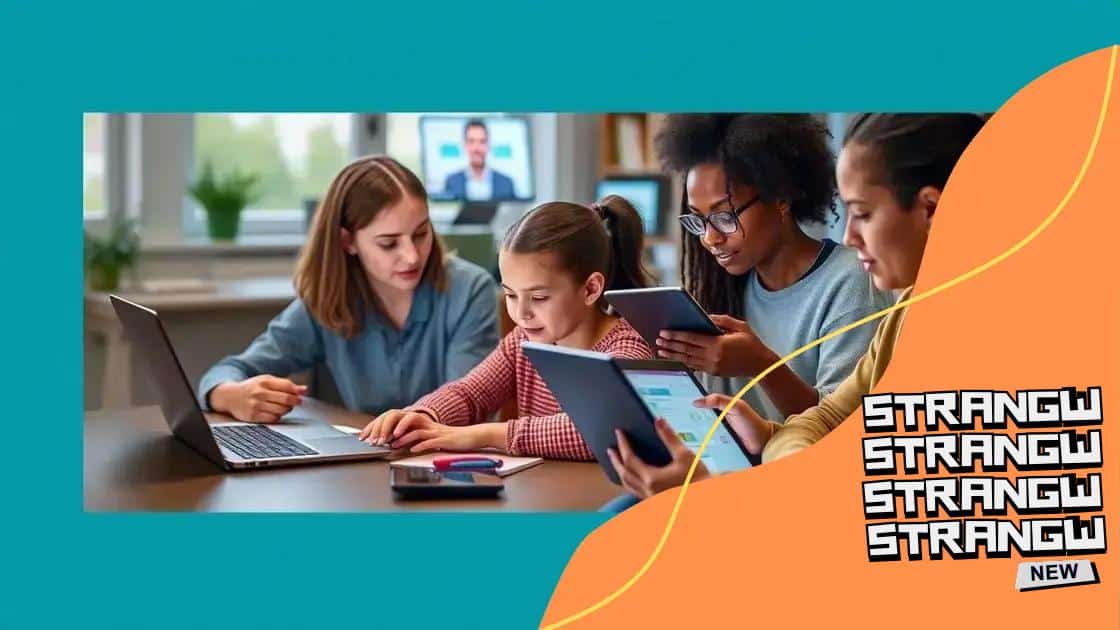Remote learning innovations that transform education

Remote learning innovations enhance education by providing flexible, accessible, and interactive experiences, allowing students to engage effectively with learning materials and collaborate with peers from various locations.
Remote learning innovations are reshaping how we engage with education today. Curious how these advancements can impact your learning experience? Let’s dive into the latest trends that make online education more engaging.
What are remote learning innovations?
Remote learning innovations have significantly changed how education is delivered and consumed. These advancements have adapted to the needs of students and teachers, making learning more accessible and engaging than ever before.
One key component of these innovations is the integration of technology in the classroom. This has allowed for various tools and platforms that enhance the learning experience. As we explore different innovations, you’ll find that they address various aspects of remote education.
Types of Remote Learning Innovations
Several types of remote learning innovations are reshaping education:
- Interactive Learning Platforms: These platforms encourage engagement through quizzes, discussions, and real-time feedback.
- Virtual Reality (VR) and Augmented Reality (AR): VR and AR provide immersive learning experiences that take students beyond traditional textbooks.
- Gamification: Integrating game elements into learning increases motivation and participation among students.
- Video Conferencing Tools: These tools allow face-to-face interactions, fostering a sense of community among learners and educators.
Another innovative approach is the use of artificial intelligence. AI can personalize learning experiences, adapting content based on individual student performance and needs. This results in a more tailored educational journey, where each student learns at their own pace.
Moreover, online collaboration tools facilitate group projects and discussions, making it easier for students to work together regardless of location. This promotes teamwork and communication skills, essential for success in today’s workforce.
Benefits of Remote Learning Innovations
The benefits of incorporating these innovations are numerous. Students enjoy greater flexibility in their learning schedules and can access a wide range of resources from anywhere. Additionally, educators have the tools to track progress and provide timely feedback, helping to support student growth effectively.
Incorporating remote learning innovations not only enhances the educational experience but also prepares students for a future where technology plays a crucial role in various professions. As remote learning continues to evolve, the opportunities for innovation will only expand, transforming education for the better.
Top trends in remote learning
The world of education is evolving rapidly, and top trends in remote learning are leading the way. With advancements in technology and teaching strategies, students now have access to more flexible and engaging learning experiences than ever before.
One of the major trends is the increased use of asynchronous learning. This allows students to access course materials, lectures, and assignments at their convenience. They can learn at their own pace and revisit challenging concepts as needed, making education more personalized.
Personalized Learning Experiences
Personalized learning is another significant trend. By using adaptive technology, educators can tailor the learning journey based on individual student needs. This can help identify gaps in knowledge and provide the necessary support.
- Data-Driven Insights: Educators can use analytics to monitor progress and adjust instruction accordingly.
- Custom Learning Paths: Students can follow unique progressions that cater to their learning style and speeds.
- Targeted Resources: Access to specific tools or materials that align with their interests and abilities enhances engagement.
Furthermore, gamification has made its way into remote learning. This approach introduces game-like elements into education, boosting motivation and encouraging active participation. Learners appreciate rewards, levels, and challenges that make their study experience fun.
Another trend is the rise of collaborative learning. Through platforms that support group work, students can engage with their peers in real-time, whether it’s through discussions, projects, or problem-solving activities. This not only builds teamwork skills but also creates a sense of community, even in physical distance.
Remote Learning Tools
The adoption of advanced tools has significantly enhanced remote classes. Learning management systems (LMS) streamline access to course materials. Video conferencing tools enable live interactions, while apps promote organization and time management. These technologies bridge the gap between teachers and students, ensuring that learning remains dynamic and interactive.
With all these trends shaping the future of education, the importance of staying current cannot be overstated. As remote learning continues to grow, embracing these trends will foster a more engaging and effective learning environment for everyone involved.
Benefits of adopting remote learning technologies

Adopting remote learning technologies comes with numerous benefits that enhance the educational experience for both students and teachers. As the landscape of education changes, understanding these advantages is crucial.
One primary benefit is the increased flexibility in learning schedules. Students can choose when and where they want to learn, allowing them to balance their studies with personal commitments. This flexibility leads to improved engagement and motivation, often resulting in better learning outcomes.
Enhanced Accessibility
Remote learning technologies also promote accessibility. Students from various geographical locations or those with disabilities can participate in classes without facing physical barriers. Online resources and materials are easily available, eliminating the need for traditional textbooks.
- 24/7 Learning: Students can access course content anytime, enabling self-paced learning.
- Diverse Learning Materials: A range of multimedia resources enhances understanding and retention of difficult concepts.
- Global Collaboration: Students can connect with peers from around the world, broadening their perspectives.
Another benefit is the potential for cost savings. Remote learning reduces commuting and housing expenses. Institutions can also save on physical infrastructure costs when implementing effective remote programs.
Moreover, technology facilitates tailored learning experiences. Adaptive learning platforms use data analytics to adjust content according to each student’s progress. This approach provides targeted support, which can significantly boost academic performance.
Improved Communication
Communication tools such as forums and messaging applications enhance interaction between students and instructors. This not only helps clarify doubts promptly but also fosters a supportive learning environment. Regular feedback is easier to facilitate in a remote setting, enabling students to improve continuously.
Embracing remote learning technologies can lead to innovative teaching methods. Educators can incorporate gamification, simulations, and real-world problem-solving into their lessons, creating a more engaging and effective learning process. These benefits demonstrate why adopting such technologies is essential for modern education.
Challenges faced in remote education
Despite the many advantages of remote education, there are several challenges that both students and educators face. Understanding these obstacles is important for improving the remote learning experience.
One significant challenge is the issue of technology access. Not all students have reliable internet connections or devices. This digital divide can lead to inequality in learning opportunities, affecting engagement and performance.
Maintaining Student Engagement
Another major hurdle is keeping students engaged in their studies. Without the physical presence of a classroom, students may become easily distracted at home. Teachers need to find new ways to keep students motivated and focused on their learning.
- Interactive Content: Incorporating videos, quizzes, and interactive tutorials can enhance engagement.
- Regular Feedback: Providing constructive feedback helps students feel connected and supported.
- Scheduled Breaks: Allowing time for breaks can help students recharge and maintain concentration.
Communication can also be a challenge in remote education. Some students may feel isolated or unsure about reaching out for help. Establishing clear communication channels is essential for fostering a supportive learning environment.
Furthermore, time management becomes a crucial skill. With the freedom to manage their schedules, students must develop self-discipline and responsibility. Without proper guidance, many may struggle to balance their tasks effectively.
Adapting to New Technologies
Also, adapting to various teaching technologies can be overwhelming for both educators and students. Learning how to use unfamiliar platforms takes time and can lead to frustration. Training and support are necessary to ensure everyone can use these tools effectively.
Finally, assessments pose unique challenges in a remote setting. Ensuring academic integrity during online exams and assignments can be difficult. Educators must find new ways to measure student understanding accurately.
Addressing these challenges is vital for the success of remote education. By recognizing issues and striving to overcome them, both students and educators can create an effective learning environment.
Tips for effective remote learning
To make the most of remote learning, there are several effective tips that can enhance the overall experience for students and educators alike. These strategies can help create a more productive and engaging learning environment.
One crucial tip is to establish a dedicated learning space. Having a specific area in your home that is quiet and free of distractions can help students focus better on their studies. This space should be equipped with all necessary materials, such as notebooks, pens, and a computer.
Set a Routine
Another important aspect is to create a consistent daily schedule. Sticking to regular study hours helps mimic the structure of traditional classrooms. Students should plan breaks as well to avoid burnout, and these breaks can include physical activities or leisure time.
- Stay Organized: Use planners or digital tools to keep track of assignments and deadlines.
- Limit Distractions: Turn off notifications on devices to maintain concentration during study sessions.
- Stay Connected: Regular check-ins with teachers and peers can help maintain relationships and support.
Incorporating interactive elements into learning can also boost engagement. This may include online discussions, group projects, and using multimedia resources such as videos and podcasts. These tools can make lessons more dynamic and enjoyable.
Moreover, practicing self-discipline is essential in a remote setting. Students should set goals for each study session and hold themselves accountable for completing their tasks. Finding a study buddy can help with motivation and provide support when needed.
Take Care of Mental Health
Furthermore, taking care of mental health is critical in remote learning. Students should be encouraged to express their feelings and know when to seek help. Engaging in hobbies or spending time outdoors can also promote well-being.
By implementing these effective tips for remote learning, students can create a more structured, engaging, and supportive educational experience. Adapting to this learning environment may take time, but with the right strategies, success is achievable.
FAQ – Frequently Asked Questions About Remote Learning
What is remote learning?
Remote learning is an educational process where students learn from a distance, often using technology and online platforms.
How can I stay organized during remote learning?
Using planners or digital tools to track assignments and deadlines can help you stay organized and manage your time effectively.
What are some effective strategies for staying focused?
Creating a dedicated study space, setting a routine, and limiting distractions can significantly improve your focus during remote learning.
How can I improve my communication with teachers?
Regularly participating in online discussions, asking questions, and providing feedback can enhance communication with your instructors.





